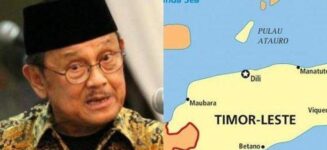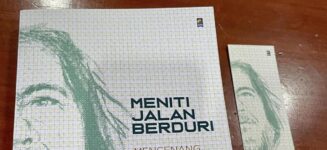The article, written in Banda Aceh, was published in The Jakarta Post March 13, 2009 http://www.thejakartapost.com/news/2009/03/13/is-gam-real-or-a-nonentity.html
Whether or not the former rebel Free Aceh Movement (GAM) still exists seems a question many consider no longer important. However, in the heat of the election campaign now sweeping over Aceh, its implications are serious.
Perceptions may turn out to be a crucial factor when the ideas involved carry symbolic significance and become articles of faith. The GAM and the meaning of the acronym, represent for the GAM a sacred icon they want to preserve. For the Indonesian military, quite the opposite, the idea represents separatism – the antithesis of their very mission of maintaining the unitary state of Indonesia.
The GAM, mindful of Acehnese identity, wishes to remain loyal to what they perceive as Aceh’s and GAM’s history. So its symbolism will remain, despite the fact that the Helsinki agreement leaves no space for a separate Acehnese state.
The Helsinki MOU allows the GAM to legitimately remain in existence, even though it is now stripped of its independence aspirations. Nothing in the MOU suggests that it is no longer relevant or indicates that it should be dissolved.
The Indonesian delegation to the Helsinki process in 2005 correctly understood this; they never questioned it. As the process drew to a close in July 2005, I recalled asking one key delegate, Sofyan Djalil, what was going to happen to the GAM. He said he left the matter wholly up to GAM leadership.
As the implementation of the MOU proceeded, however, the Aceh Monitoring Mission (AMM) tried to push GAM leaders to dissolve the movement, to no avail.
Problems arose as the GAM, now represented by several bodies, groups and individuals, won the 2006 local elections. They were mainly represented in the Aceh Transition Committee (KPA) and the Aceh Party (Partai Aceh) while GAM leadership remains in Sweden. Individual GAM members have since been split in different factions, but most remain loyal to GAM leadership, the KPA and the Aceh Party.
There are different factions and perceptions as well in Jakarta. Nationalist legislators and (retired) military officers have always been very suspicious of the GAM. They made noise about the continuing existence of the GAM and rejected the name “Partai GAM”. A political party, they said, cannot, at the same time, be a movement (yet now there is a party which is also a movement or gerakan i.e. the Greater Indonesia Movement Party or Gerindra).
In reality, their greatest fear concerns the “M” (for merdeka or independence) of the GAM and its alleged “hidden agenda”. This writer has noted in discussions with local officers and Jakarta politicians a strong presumption that the GAM will use its democratically won political victory as a future basis to demand a referendum.
Hence, they feel as if they had been cheated when GAM leaders won the governorship and many district chief positions in the 2006 elections. Now they say we should be worrying about the GAM dominating the 2009 local legislation.
Sidney Jones, International Crisis Group’s senior adviser has pointed out the great sensitivity to the symbolism that explicitly links the Aceh Party, the GAM and its aged leader Hasan di Tiro.
Military officers may have different styles of responding to the political development, some by being politically correct and, at the other extreme, some by shouting – as has been quoted by many – that “the Helsinki MOU is the greatest lie in Indonesian history”. The latter is worrying and needs correction.
Such responses may be just different styles of the same basic proposition based on their training and historic experience. “State sovereignty” is a sacred concept in pre-colonial kingdoms and in independent Indonesia. When it comes to it, the presence of alien forces and the role of foreigners are taboo.
And its consequences are severe: First, the Dutch attempt in the 1940s to regain Indonesia incited the war of independence; second, the United Nation’s role to resolve the East Timor issue and hold a plebiscite in 1999 ended in a bloody conflict.
Now it seems the Helsinki MOU is yet again seen as “foreign intervention”. Some have urged that consultation on the MOU and foreign election observers are no longer necessary.
Amid the election campaign, paranoia has led to terror and xenophobia aimed at preventing GAM representatives’ victory. There have been about 20 incidents targeting the KPA and the Aceh Party. So far, no suspects have been arrested, but the series of assaults appeared systematic as it, up to last year, targeted vehicles and offices only, but since January, has victimized GAM leaders, as in Bireuen and Ujung Kalak, West Aceh.
Given the rising tensions, President Susilo Bambang Yudhoyono and the visiting Aceh peacemaker former Finnish president Martti Ahtisaari were clearly forced to issue a stern warning against such attempts to subvert the peace process.
On the GAM side, there is no question of the popularity of the Aceh Party. But its dominance has often been used to intimidate other parties. The KPA and the Aceh Party are worried about the apparent persecution, but they too – like those who denigrate the Helsinki MOU – need to behave.
The GAM and “nationalist” officers, each from their opposite points of view, treat GAM symbolism as opposite articles of faith. Both should be reminded that they are bound to implement the Helsinki pact which respects democracy.
While the “nationalist” view on GAM’s predicament remains as paranoid and confusing as this saying suggests, Cut Farah, reflecting ex-GAM combatants’ views, made it clear that the GAM – i.e. its armed movement – “now no longer exists as it now strives toward democracy based on the Helsinki MOU”.
In other words, whatever the nature of the GAM, it is the KPA and the Aceh party that actually operate on the ground.
None of this violates the Helsinki MOU, but only if and when the pact is fully implemented, may the GAM’s existence logically no longer be relevant.
The writer is Radio Nederland Jakarta correspondent



